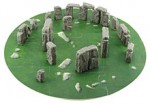Did you know that the low hanging, large, reddish moon that would be called a Harvest Moon in late September/Early October is called a Strawberry Moon when it happens near the solstice?Â
The summer solstice was yesterday, June 20, at 7:59 PM EDT, so I thought I’d do a quick roundup of  ways some folks mark this longest day of the year.
Â
Traditional
Flowers: Gathering nine different types of flowers and placing them under your pillow on the solstice is supposed to make you dream of the person you will marry. Nine is a number sacred to the old Nordic and Saxon gods (which is why there are nine Vikings in my crew of Immortal Warriors.)
Weddings: Druids celebrated the summer solstice as a marriage of heaven and earth, which is why June is the month for weddings
Bonfires. Â In Cornwall in the old days, every peak and hall glowed with light on Midsummer Eve as the fires begged the sun not to retreat into winters darkness.
Spirals: Â Ancient solar dances would spiral in to the center and back out again, representing the path of the sun.
Herbs: Practioners of herbal magic believe that herbs gathered at the solstice are imbued with extra potency.
Stones: Tracking the sun was immensely important to early people, so they knew when to plant and harvest and when to honor their gods—so important that they would spend years building what amounted to giant stone calendars. Stonehenge is the most famous of these, but Machu Pichu, New Grange, the Sun Dagger of Chaco Canyon, and dozens of other stone sites around the world served the same function.
Â
Modern
Parades: Seattle’s Fremont District (The Center of the Universe) holds a fair and a wild parade to celebrate the solstice and the amazing energy of the neighborhood.Â
Nativity of St. John the Baptist: Â This Christianized version of the solstice marks the birth of this important saint (unlike most feast days, which celebrate the martyrdom of the saint). Â Particularly important in northern and eastern Europe and the celtic countries (where the solstice was also key), it is one of the most solemn of Catholic holy days, even celebrated when it falls on a Sunday (also not typical for a saint’s day).
Picnics and Bonfires: In Denmark and other countries, Midsummer is marked by spending much of the day outside, ending with a nice bonfire on the beach.
Stones: In the tradition of the great ancient builders, my husband recently put the item “Stonehenge” on the whiteboard that his team uses to keep track of projects at work.  Yesterday, he assembled his personal mini-Stonehenge kit (carefully aligned, of course) and crossed the item off the list. No one noticed. Sigh.
He intends to do it again in December anyway.
How do you celebrate Midsummer?
Â
Â
Â
Â


Permalink
Oh, we celebrate by sneezing, ALL DAY LONG. Really, a fun family activity. 😉
Like the husband’s Stonehenge.
Permalink
In Arizona, we sit in our air conditioned homes and PRAY for fall. On said day of solstice it was 115 degrees here. Not too many naked Druids out observing the Strawberry moon, I’m afraid. It was still too darned hot outside!!! Perhaps that’s why all the aforementioned observences happened in more northern climes! So, happy solstice to all, but don’t mind when we aren’t all that exited! Now, talk to us about Haloween….that’s a holiday we can get behind. It will only be upper 80’s then!